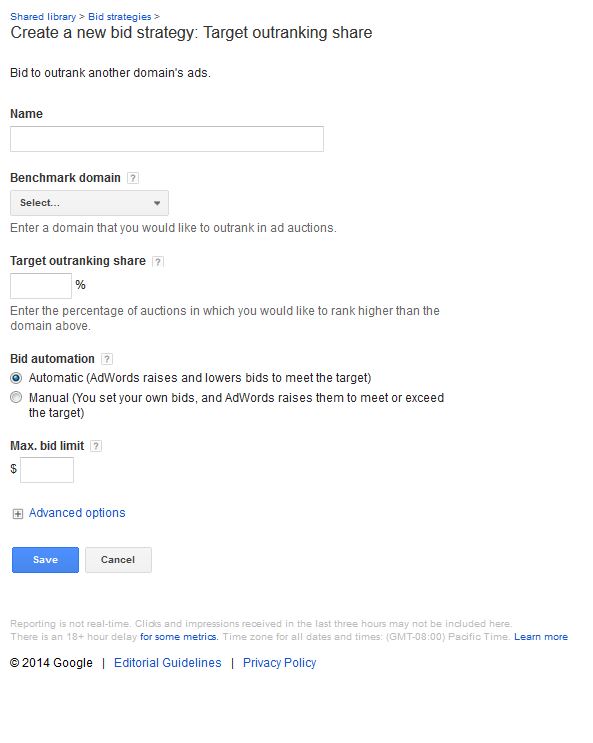Having a hard time out-bidding your biggest competitors with any of your keyword search campaigns? There’s a new, and more discreetly implemented bid strategy that can help you show your ads above the competition whom you thought were ‘above your reach.’ With Google’s new bid strategy “Target outranking share,” you can do just that.
There has been no official AdWords blog post on the specific strategy yet, but here is a quick synopsis:
The “Target outranking share” uses your auction insights to come up with benchmark domains to outrank or the option to add your own specific competitive domain to outrank. Then, just indicate an outranking impression share you like along with a max bid and advanced options that include only increasing bids that don’t have low quality scores. The interesting part about this option is it does not directly indicate what a ‘low quality score’ is in relation to this strategy.

This type of bidding implementation could be a game changer with how we, as advertisers, bid against our competitors, especially those big, “bottomless pocket” guys who always seem to eat up the page and drive up bids. It also opens up new opportunities to not only target a competitor’s brand name, which has become increasingly difficult, but also target competitive service/product keywords and outrank the competition in an impression share stance, instead of just a ‘top of page’ bid strategy stance.
For the travel industry, this means having a better chance of outranking an OTA (Online Travel Agent). For e-commerce product businesses, it means having a better chance of outranking Amazon, Zappos, or any of the big-box stores.
The list could go on, but this should get your creative juices flowing on figuring out how to best utilize this bid strategy.
 I have put together three best practices on how to use the Target Outranking Share bidding strategy most eeffectively
I have put together three best practices on how to use the Target Outranking Share bidding strategy most eeffectively
- Pick your competitors wisely and strategically. Just because you can go up against Amazon doesn’t mean you should.
- Play it safe and bid appropriately. Just like with any of Google’s bid strategies, this is an automated process and lets you out of the driver’s seat, managing all the bidding and so forth to maximize that outranking share. This can either turn out to be profitable and show value or turn a once successful account CPA on its head. So, just be careful when first starting out.
- Create a separate campaign. This will give you more control over budget and competitor strategy including keyword/competitor testing.
Pick your Competitor Wisely
Since this bid strategy only allows for one competitor per iteration, make sure to look at not only the list Google gives in both the benchmark domains and auction insights, but also your own outside competitor analysis and insight. Since you can specify your own URL, use that to hone in on that main competitor-sore that keeps you up at night.
Keep in mind, there are multiple parts of this equation. Just because they outrank you 50% of the time doesn’t mean they show up very often.
It may look like this:
Competitor A outranks my ad 90% of the time, but only competes with my ad 25% of the time.
Whereas,
Competitor B outranks my ad 75% of the time, but competes with my ad 40% of the time.
And finally,
Competitor C outranks my ad 60% of the time, but actually competes with the ad 80% of the time.
In this scenario, Competitor B and C are both worthwhile to target outranking share, but Competitor C is truly where the most value may lie. They tend to be the most relevant competitors by competing with the ad 80% of the time. SO, even though they only outrank 60%, that 60% may equate to lost sales because Competitor C is seen almost as often as you for that product or service.
Play It Safe and Bid Appropriately
Don’t do choose the 100% impression share max option. Just like bids, be conservative and strategic. Don’t waste your entire daily budget trying to outbid one competitor as it may not be as profitable, based on the keywords in competition.
When there is a chance to dominate, it’s hard not to take it, but playing it safe and playing defensively can have better payoff than going 110% out of the gate. This means, try to shoot for beating the domain 30-50% of the share first to see how it pays off. Then if there is valuable return, start incrementally increasing that outranking share 10%-20% to analyze any if there is a diminishing return.
Create a Separate Campaign
Expounding on the ‘play it safe’ rule – create a separate campaign dedicated to this strategy. I talk about this a lot in my overall campaign strategy, but with this bid strategy specifically, it helps differentiate competitor keywords from higher value, successful keyword campaigns.
This will allow for specific budget allocation. Personally, I name the campaign to indicate it is a ‘competitive’/’competitor’ strategy. In doing this, you won’t ruin any quality keywords by adding them to the mix, plus you can single out specific ad group keyword themes to compete against different domains based on whether or not certain keywords have a different competitor set.
The main point to remember is if you move keywords, make sure you pause the old campaign or ad group in order to avoid cannibalization. Also, only move keywords with low conversion volume or low click volume.
All of these tactics will help successfully use the “Target outranking share” bid strategy. I do advise using it as a brand awareness campaign initially, until the desired results are shown through either conversions or other set-values, as this strategy will work more like most other competitor campaigns. Especially if you only use keywords that need more visibility and have a hard time getting clicks and conversions due to the higher-paying competitors.
Finally, bid strategies are a great tool for good performing campaigns that could use a new form of testing to see what kind of extra ‘juice’ can be squeezed out of an already successful results. Watch it closely and good luck in your newest endeavors!
Image Credits
Featured Image: Pexels.com. Creative commons
Screenshot taken 12/5/2014 of Google AdWords Blog
Screenshot taken 12/5/2014 of Google AdWords Bidding Strategy





